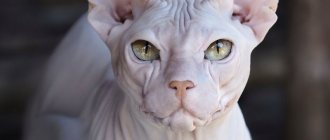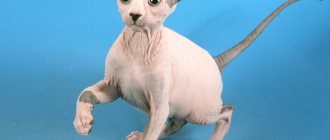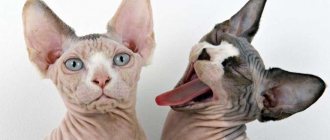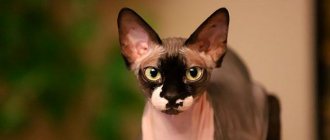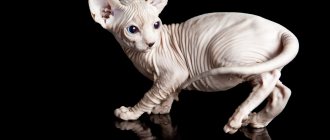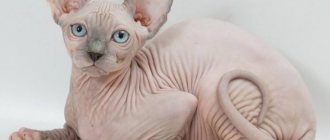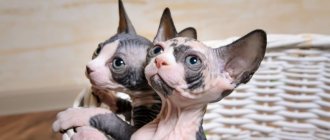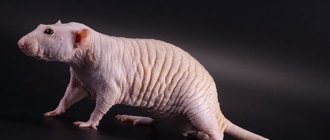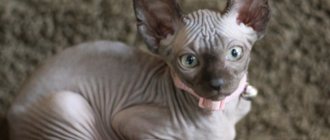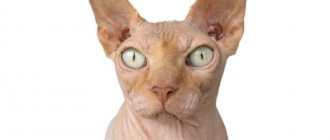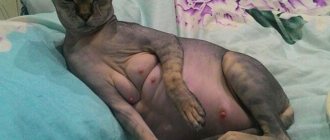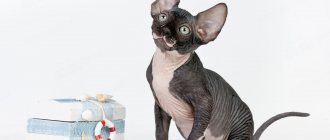Don Sphynxes are hairless cats with large ears, folded skin and a distant look. Their pretentious appearance makes a lasting impression.
A good-natured and gentle disposition, as well as affection for the owner, make these animals real couch physiotherapists. To make life with a Donchak comfortable for both the cat and the owner, you need to understand the specifics of the breed.
Brief history of the breed
The small homeland of these hairless cats is Rostov-on-Don.
In the late 1980s, city resident Elena Kovaleva picked up a stray cat. The woman named the foundling Varvara and treated her for baldness for a long time. When it became clear that the therapy was not bringing results, it was decided to leave the cat alone.
Having matured, Varvara gave birth to babies from the local cat Vasily. One girl from the litter turned out to be as hairless as her mother. The unusual cat was named Chita and began to be used for breeding purposes.
In 1992, an experimental breed standard was created. In 1997, the Donetsk team received recognition from the WCF. Today, the Rostov Sphinx is recognized by all major felinological organizations.
History of the origin of the Don Sphinx
Russia is recognized as the country of origin of the breed. It was here in the winter of 1986 that a resident of the Rostov region saved a stray kitten from the hands of hooligans.
The rescued animal turned out to be a girl. The owner called her Varvara and began to nurse her. Despite the care, the cat soon began to go bald on her back. She was taken to doctors, but they just threw up their hands. Judging by the tests, the animal was absolutely healthy.
Only 2 years later, Varvara, with the pitiful remains of her former fur coat, was examined by felinologists, but did not make an impression on them. She was noticed only in 1990, when, after mating with a shorthaired European cat, she gave birth to one practically hairless kitten. The baby, named Chita, interested the breeder Irina Nemykina. The woman took the future founder of the breed with her and began breeding experiments.
Chita was balder than Varvara, but some hair was present on her paws and tail. Subsequent matings with short-haired partners did not give the desired results. The fur did not disappear. Then Nemykina decided to resort to inbreeding, that is, mating close relatives.
Her efforts paid off. The first completely hairless kitten was a baby named Basya Mif. In 1996, hairless wards received official recognition and their name.
Due to the small number of Donchaks, until 2000 they continued to be bred with European Shorthairs, Russian Blues, Siamese and Angoras. One of these experiments led to the formation of another breed - the Peterbald.
Varieties
Depending on the type and structure of the coat, representatives of the Don Sphynx breed are divided into types:
- velor: at birth, such cats are covered with hair 2-3 mm long. As they grow older, the hairs fall out, completely exposing the skin;
- Brush: The body of these Don Chaks is covered with long, hard, curly hair. Usually, by the age of two years, Don Sphynxes of this type become completely or partially bald;
- flock: A cat's skin is covered with fine, short hair that looks more like down. Over time, the hair falls out;
- hairless (“rubber”): these Don Sphynxes are born completely hairless, and their bodies are covered with hot, wrinkled skin.
On a note. Donchak dogs with brushed wool are not allowed for exhibitions, but are quite suitable for breeding.
In turn, the velor sphinx type has varieties:
- light velor - with wool no longer than 2 mm;
- velor point - with short pile on the paws and muzzle up to 4 mm long;
- downy velor - with soft fur all over the body.
Brash Don Sphynxes are also divided into:
- brush velor: with hair no longer than 0.5 cm. As the cat gets older, the cover changes to a thin flock in the neck, back and sides;
- brush point: at birth, babies have thick fur. By the age of one and a half years, the cover of such Donchak becomes thinner. The tail and muzzle of the sphinx are overgrown with short, thick hair. The remaining parts of the cat's body are covered with light velor;
- dense brush: with thick hair, under which the Donchak skin is not visible.
Owner reviews
From the very first days, Koska identified me as his mistress unconditionally. This means constant communication, jumping into arms, grabbing with paws, purring from all sides and an offended, perplexed look if I do not obey. The cat sincerely does not understand how it is possible not to take him in your arms at the first request or not let him sit on your knees. Cat petting around the clock, with short breaks for sleep and food, this borders on intrusiveness.
Vera Golubeva
https://irecommend.ru/content/donskoi-sfinks-koshka-kotoraya-gulyaet-sama-po-sebe-net-neteto-koshka-kotoraya-gulyaet-po-te
Playful, jumping, vocal. She ate, said thank you, meow; I went to the potty, meow - clean it up. And as she walked, there was a completely wild scream. It became easier after sterilization. And as soon as the grandchildren cry, he immediately calls: go calm the kids down, otherwise I will bite you. The character is still the same, I don’t want it and don’t touch me. My beloved mistress is mine alone and I won’t give it all away to anyone. When I get home, he runs around for half an hour cursing: where have you been? Well, the housewife gets her dirty butt after using the toilet. It seems like the cat is licking itself, but its body temperature is 40 degrees, so everything sticks, you have to wash it. So it's fun. And there are no other problems. He sleeps under the owner’s blanket, if it’s cold he climbs onto his stomach, or under his side. She goes into the potty without any problems, that’s clear, she gnawed on the violets a long time ago.
Lucinda0309
https://irecommend.ru/content/khotite-myt-koshachyu-popu-zavedite-donskogo-sfinksa
I have never met more affectionate and intelligent animals. I came across a black cat. I read on the Internet that Don sphinxes can heal people, but I didn’t take it very seriously. Over the course of 10 months, my cat licked the thyroid gland on my neck, which was enlarged by 40%. When I was told at the ultrasound that the Don Sphynxes were being treated, I was shocked!!! I saw the results myself. Moreover, donchak have a final visual memory. I walk her on a leash down the street. I go to the store with her. Sits in the basket - doesn’t jump out - looks at everyone - inquisitive. If you are accustomed to water from childhood - not to be afraid of water - they love to swim and bathe. In winter it's as good as hot water bottles. They love to kiss, play, meet you at the door, and see you off. They are not picky about food. They are like lie detectors to me. We stopped buying many products in stores. We let the Donets smell it - if they eat it, then it’s a good product, if they don’t eat it, we don’t buy these products anymore.
https://otzovik.com/review_119241.html
Loves children very much. But it is better for children to reach the age of 4–5 years so that they understand how to treat a pet. With younger children it’s more difficult; they know what’s not allowed, but they don’t always follow the rules. Now my daughter is 4 years old and she knows how to behave with a cat; before, it happened to both of them, naturally from each other. Therefore, I would not recommend having a cat with small children, so as not to injure any of your loved ones.
Gulnaz1
https://tutux.ru/opinion.php?id=22481
A kitten, or any other animal, is another child at home. Well, how can you not love her? Now I can’t even imagine having a wool cat at home with hair everywhere. But this breed requires constant care - we clean its ears and eyes every day. The body temperature of Don Sphynxes is 42 degrees, so they are always cold and hide under the blanket. At night he always sleeps with me and warms me like a hot water bottle. She doesn’t like to wash in the bathroom, but she likes the bath. This is our bald head - the most wonderful!
lena782008
https://spasibovsem.ru/responses/lysiki-luchshe-vseh.html
We also got a Donskoy, when I adopted it... I’ll be honest... I wasn’t very aware of the “peculiarities” of this breed. Everything was fine with us until I found myself in a position. As soon as the cat was replaced, he began to shit... about the litter box and the garbage, still the same... from the toilet he manages to spread the litter throughout the apartment, and there is now a small child in the house who is constantly crawling everywhere. All I have time to do is walk around with a broom and a rag (All the window sills are dirty, the radiators are dirty in the winter too, because he heats up on them... There’s always someone walking around yelling... it especially pushes when you just put the child to bed. You need to sleep exclusively on the bed, exclusively under the blanket, of course, while he gets under the blanket... he lifts up the bedspread, and with it the bed linen... after 2 days the linen can be changed, because it is all dirty from him. And what kills me most is that he does not wash himself!! !! In general! Some kind of underdog))))….he can hang “snot” on his face and walk like that..Yes, it’s better to have wool than dirt and stench!
npp
https://otzov-mf.ru/poroda-koshek-donskoj-sfinks-otzyvy/
Yes, of course, a cat of this breed is very active, they will not let you be alone and get bored. He will always follow you wherever you go. These cats love to be in the arms of people, even if it is the owner or a stranger. They quickly adapt to strangers. I would even call this breed somewhat annoying; it would be extremely difficult to drive it into another room where there is no one. Our cat was also quite vocal. She meowed almost always, mostly she begged for food. No, don't think we starved her. It’s just that these animals constantly want to eat, no matter how much they put in their bowl, after half an hour the next begging for food will begin again. As they explained to me, this happens because they are hairless animals, and in order to keep warm, they expend more energy than other cats. In general, we fed her countless times a day, but this did not affect her figure in any way. Speaking of loudness. Initially, we wanted to pursue her exhibition career. because she came to us with documents. But as soon as she started having troubles for the first time (and it started early - at six months), we gave up on breeding a cat, because she just really asked for a cat. She walked for about five days, then there was a lull, and about a week later the cat began begging again. In short, we couldn’t stand it and invited the veterinarian home for sterilization. There are cats that walk almost unnoticed. For example, my relatives have a British cat, she squeaks a little only when she is in heat. But this is not about the Don sphinxes.
Yuli89
https://nashemnenie.com/zhivotnye/18195-donskoy-sfinks.html
Now he is more than four years old, he has excellent relationships with us, and with our guests, and with other animals with whom he had to get acquainted from time to time (only the bird that accidentally flew into us was unlucky - he instantly killed it). He sleeps exclusively in our bed, is normal about bathing, and without any problems endured moving first to another city (25 hours on a train), and then to another country (2 flights).
froshik
https://citykey.net/review/moy-laskovyy-i-nezhnyy-zver-foto
Personally, I have two Donetsk cats. I am very happy with my babies. This is the most beautiful and loyal cat breed. My first girl came to me three years ago, a little purring little warmer, then I was just learning about care and everything else, a year ago I bought another cat. And I'm completely satisfied with them. This breed is very loyal, cats are able to remember and understand the speech of a three-year-old child, talk to them and back up your words with actions and your brachiki will pleasantly surprise you, they will not only understand you but also follow your verbal instructions. But there is, but only for those who are waiting for a naked pet, not all of them undress, I have one cat left with a veil and with hair on its paws and tail.
Periong
https://otzyv.expert/otlichnie-umnie-koshki-1513105
Interesting Facts
Fans who are not indifferent to the Don Sphynx cat breed discover interesting facts when getting to know her:
- These hairless animals need constant communication with people and do not miss the opportunity to touch them. Because of this feature, they are often called “kissing” cats;
- The skin of Don sphinxes is comparable to human skin. Under the influence of the sun, a tan appears on it, sweat appears in the heat;
- Don Sphynxes were used to develop a new breed called the Peterbald. For this purpose, hairless cats were bred with Turkish Angora, Siamese and Russian Blues.
Basic moments
This cat is attractive not only for its unusual appearance. There are several benefits to keeping it in your home. The Don Sphinxes can be characterized as follows:
- very smart, obedient;
- loyal to the owner, strongly attached to him;
- good-natured, considered the most peaceful pets;
- friendly and affectionate, they require constant human contact;
- require a lot of attention, can be offended if they do not receive it;
- active, inquisitive, love to play;
- very jumping, can jump up to 1 m in length, easily master various tricks;
- requires minimal coat care, does not shed, and is a hypoallergenic breed;
- the body is soft, pleasant to the touch and very warm, temperature up to 42˚;
- They are only suitable for keeping indoors, as they constantly freeze and are afraid of drafts, so it is not recommended to let them outside;
- get along well with other pets and children;
- due to active metabolism, these cats have an increased appetite, they are constantly hungry, swallow food without chewing;
- they love to bask in the sun, but their skin is sensitive to ultraviolet rays and burns quickly appear;
- just like a person’s skin is prone to tanning and can sweat;
- the immune system is strong, but skin diseases often develop;
- the skin secretes a special substance similar to wax, brownish in color; with insufficient hygiene, pets can stain furniture;
- they have long flexible fingers on their front paws; cats can use them to pick up food and other objects;
- The peculiarity of kittens of this breed is that they are born sighted immediately or open their eyes after a few hours.
Breed description, standards, appearance
The Don Sphynx is a harmonious cat with strong bones and hot, velvety skin. She has a memorable appearance that evokes associations with an alien.
The anatomical characteristics of the Donchak are specified in detail in the breed standard.
Dimensions and weight
The Don Sphynx cat is considered a medium-sized animal. It grows to 25-30 cm at the withers. The weight of an adult female is 3.5-5 kg. The Donchak cat weighs up to 7 kg.
Anatomical characteristics
A typical hairless cat must conform to the official breed description. A real Don Sphynx looks like this:
- the head is wedge-shaped, with a flat forehead, clearly defined cheekbones and developed eyebrows. The nose is straight, the whisker pads are visualized;
- eyes are medium-sized, almond-shaped. The color of the iris depends on the base color;
- The ears are set wide apart and large. The tips are rounded. The external contours do not protrude beyond the cheek line;
- the body is strong, with developed muscles, a straight back and graceful posture;
- limbs are long and thin. The paw pads are oblong. Fingers extended;
- the tail is long, flexible, without bends.
Skin and color
Don Sphynxes have elastic skin that gathers in folds in the groin, armpits and forehead. The skin is almost hot to the touch.
The color of cats without fur on their bodies is determined by skin pigmentation. According to the Donetsk standard, any colors are allowed. Most often found in the breed:
- ginger;
- lilac;
- black;
- blue;
- white;
- red-pink;
- chocolate;
- cream;
- tabby;
- calico;
- smoky (gray).
Possible breed defects
The disadvantages, in the presence of which the Don Sphynxes will not receive a high expert assessment, include:
- Round eyes;
- undershot up to 2 mm;
- short, narrow or round head;
- complete pubescence;
- short or irregularly ending tail;
- low-set or small ears;
- weak, light or shortened body.
Important! Donchak dogs with an inversion of the eyelids or an underbite of more than 2 mm do not participate in exhibitions and are not used for breeding.
Breeding Features
Sphynxes are distinguished by their early stages of puberty. Despite the fact that the first estrus in “Donetsk” dogs can occur as early as six months of age, it is nevertheless not suitable for reproducing offspring. Both sexes should be allowed to breed at least two years of age.
The features themselves:
- Mating must be preceded by vaccination.
- It is not permissible to bathe “Donetsk” dogs before mating.
- Mating may not give the desired results if the cat and cat are participating in this process for the first time.
- Sphynxes are usually bred in the male's territory.
- Mating "Donchan" consists of several matings with a two-day periodicity, so that the pussy becomes pregnant for sure.
- A pet that is in an “interesting” situation will require an increased amount of affection and attention from cat owners from the first days.
- It will be better if the entire period of pregnancy and childbirth in Don pussies is supervised by the treating aibolit in order to avoid the loss of offspring and other complications.
- “Donetsk women” bear kittens for approximately 63 days.
- By the fourth week, the nipples of the pussy increase somewhat in size and “color” pink.
- The pet is gradually gaining weight. Her belly is growing. Movements and gait become rigid.
Before giving birth, caring cat owners should take care of arranging a place for the birth of future Don Sphynx kittens. A low box or drawer, the bottom of which is covered with soft bedding, is suitable for this.
Childbirth for Don pussies can last about a day. Often, “mommy” copes with this process on her own. Basically, there can be 4-6 individuals in one litter.
Character and temperament
Don Sphynxes are soft and vulnerable cats that require constant communication with humans. They are not prone to aggression and are absolutely not jealous. Good-natured Donetsk people are easy to offend, but difficult to anger.
The gentle, hairless cats love attention and often sit on their owners' laps. At the same time, they are not prone to excessive intrusiveness and will not bother with tenderness to those who do not need them.
Don Sphynxes are moderately lazy animals. They will be equally happy to engage in standard cat activities and spend time sitting comfortably on a warm radiator.
Breed and children
Sociable Don Sphynxes get along well with children of different ages. They never allow themselves to attack children. Donchak people happily take part in funny children's pranks.
Breed and other animals
The character of cats of the Don Sphynx breed is non-conflicting. This allows them to live peacefully in the same territory not only with their relatives and non-aggressive dogs, but also with guinea pigs, parrots and hamsters.
The character of the Don Sphynx
The friendliness of the Donchak cannot be ignored. This cat is hospitable to strangers and does not mind sitting in their arms upon first meeting. He will never scratch or bite his playmate, so you can safely leave him with small children.
Also, a bald pet does not mind playing with other pets. His social circle is not limited even to rodents and birds. Donchak immediately understands that small pets are family members just like him, which means they must be treated with care and love.
The character of the Don Sphynx is moderately lazy. He shows the greatest activity in childhood, and with age he becomes balanced. Despite this, the Donchak will never refuse to play with his beloved owner.
Representatives of this breed have developed intelligence. Their dexterous long fingers skillfully open door locks and kitchen cabinets. Animals are also able to detect the owner’s mood and health problems.
A tame pet never imposes its communication if it sees that a person is busy. But in case of illness, he will definitely lie down on the sore spot and warm it with his warmth, trying to alleviate the condition of the sick person.
How to choose the right kitten
Little Don Sphynxes are fragile and gentle creatures. They are susceptible to various diseases and often die at the age of several weeks. In order not to lose a newly adopted pet, it is advisable to purchase a kitten of this breed no earlier than he is 3 months old.
It is better to buy a Donchak from a specialized nursery or from a trusted breeder. At the time of sale, the Sphynx must have a veterinary passport with vaccination marks and a metric that confirms purebred.
A healthy kitten has a neat appearance and is actively interested in everything that happens around. It is important that he does not have a bloated belly, watery eyes, dirt under his tail, or scratched or flaky skin.
Kitten care
Little Don Sphynx cats are taken from their mother at the age of 12 weeks. By this time, the kittens are already quite independent. They know how to eat, know the scratching post and are litter box trained. Therefore, new Donchak owners just need to give the pet time to get used to the changed conditions and show him places where he can eat, drink, go to the toilet and sharpen his claws.
For safety reasons, wires, indoor plants, household chemicals and small objects are hidden from the baby Sphynx. A curious kitten can climb into the most unexpected places. Therefore, before turning on the washing machine or oven, you should definitely look inside to make sure that there is no curious animal there.
Tips for choosing a kitten
It is recommended to buy Don Sphynx kittens no earlier than 3-4 months. At an early age, animals are very weak and can die if left without a mother.
It is better to choose a future pet from a licensed nursery. Such institutions confirm the health of their pupils with veterinary passports and are ready to provide all other documents upon the first request of the buyer.
At your first consultation with staff, ask to see the babies' mother and father. Usually the character of the parents is passed on to all offspring.
Also evaluate the appearance of the animals. What is important here is not only compliance with the standard, but also the absence of painful symptoms. Neither parents nor children should have any flaking, runny nose, cough or bloated belly.
If you want to choose a more affectionate pet, then take a girl. Boys are more independent, but also more playful. Also, their skin has an intense smell of fresh milk with spicy spices.
Care and maintenance
Don Sphynxes are heat-loving animals that prefer to spend time near heating devices or in the sun. Therefore, cats of this breed should only be kept at home.
Caring for a Donchak is not at all difficult. The main thing is to do this regularly.
Hygiene procedures
The eyes of Don Chaks are not protected by eyelashes and require special care. They are wiped daily with a cotton pad soaked in chamomile infusion or boiled water. If redness or purulent discharge is detected, the Don Sphynx must be shown to a veterinarian.
The cat's ears are wiped twice a week with a cotton swab moistened with a special lotion. This is done very carefully so as not to damage the organ.
Read more about proper hygienic cleaning of the Sphynx's ears and eyes.
The claws of the Don Sphynx are periodically shortened with a claw cutter. The procedure is carried out with utmost care so as not to touch living tissue.
Donchak's teeth are cleaned 2 times a week with a silicone brush with a small amount of special paste for animals.
Skin care
Don Sphynxes sweat, and their skin secretes a protective brown lubricant. That’s why these cats are bathed more often than representatives of other breeds.
Donetsk residents are provided with bathing procedures 1-2 times a month. Wash them using a natural mild or cleansing antibacterial shampoo.
In addition, the skin of hairless cats is wiped daily with a linen or cotton cloth, which is moistened with a caring lotion or boiled water.
On a note. In summer, the Donchak skin is protected from ultraviolet radiation by lubricating it with special creams.
Tray
The Don Sphynx is a clean cat, he quickly gets used to going to the toilet in a designated place. A spacious plastic tray is selected for it, which does not absorb odors.
Any filler can be used. The main thing is that the Donetsk likes him and copes with his functions.
Raising the Don Sphynx
The upbringing of a Donchak begins from the first days of his appearance in the house. At first, the baby may attack his hands, scratch furniture and chew his slippers. This behavior can quickly be eliminated if you understand how to properly raise a cat.
Prevent any unwanted actions with a loud sound (clapping your hands), spraying water or hissing. A sharp noise and suddenly appearing liquid frighten the animal, distracting it from its mischief. Over time, the pet notices the relationship and stops misbehaving.
Full training, including teaching basic commands and simple tricks, is possible, but will require effort. To achieve results, you will have to interest your bald pet. He is capable of a lot, but will not perform any actions without the desire. In this case, a game form of learning works best.
Donchak people quickly understand how to use not only a litter box, but also an ordinary human toilet. Despite the ingenuity, relief from need does not always go smoothly. Even a well-mannered pet can begin to mark its territory. The only plus is that the tags are odorless.
You will have to deal with unwanted behavior using the same techniques, adding oilcloth to the “latrine”. Its specific smell is unpleasant for the cat, so it will quickly forget the way to the restricted area.
Sphynx cats hate grooming. Washing, drying and trimming nails turns into a real test of strength. For more adequate behavior of your pet, try to accustom him to hygiene procedures from early childhood. Otherwise, only a professional groomer can handle it, but the cat’s psyche will still be crippled.
Looking for the Don Sphynx? Find your pet from 1 offer As a gift
Feeding the cat
Don Sphynxes are distinguished by accelerated metabolism and increased heat transfer. Hairless cats require more food to maintain their body temperature than other breeds.
Complete diet
When fed dry food, the Don Sphynx is given premium, super-premium or holistic-class products, which do not contain any questionable components.
The best brands to meet these criteria are RoyalCanin, ProPlan, Hills, Acana and 1st Choice.
When feeding natural products, the menu for Donchak is designed so that lean, fresh meat predominates in it. The sphinx is also given:
- sea fish;
- eggs;
- dairy products;
- porridge with water;
- boiled vegetables.
Don Sphynx dogs should not be offered pork, river fish, bones, sweets, baked goods, smoked meats or sausages. It is forbidden to feed cats of this breed salty, spicy, fried and fatty foods, as well as leftovers from the owner’s plate.
Feeding frequency
Small Don Sphynxes eat less and more often than adult representatives of the breed. Therefore, the diet is made taking into account the age of the cat:
- up to 3 months – 5 times a day;
- 3-6 months – 4 times a day;
- from 6 months – 3 times a day.
Vitamins and minerals
If the Don Sphynx eats natural food, a lack of microelements may occur in its body. Therefore, it is recommended to give vitamins to a cat of this breed twice a year in courses.
But, before introducing mineral supplements into the Donchak’s diet, it is better to show the Sphynx to a veterinarian. He will assess the animal’s condition and recommend suitable vitamins.
On a note. Don Sphynxes, which feed on dry food, do not need additional mineral supplements. Industrial feed contains the entire range of useful substances.
Sterilization and castration
Animals with which it is not planned to engage in breeding must be castrated or sterilized to avoid unwanted matings. In addition, animals behave much calmer after such operations. Many breeders give kittens already castrated or sterilized. This is often stated in a separate clause in the contract.
It is better for females to have this operation done before their first heat, at about 8–10 months. It is possible later, but it is advised to do this no later than two years. Experienced breeders recommend spaying or neutering males up to 6 months while the pet is not yet fully grown. Otherwise, it may be too large with a large head.
The older the pet, the worse it tolerates surgery.
After surgical procedures, the animal must be carefully observed and well cared for. Postoperative care is as follows:
- after the operation, you must immediately put a special blanket or collar on your pet so that he does not lick the stitches;
- once a day, the seams are treated with disinfectant solutions (hydrogen peroxide, chlorhexidine, etc.);
- limit the cat’s physical activity;
- provide the pet with peace and quiet so that it is not disturbed by children or other pets;
- do not give food for 8–10 hours after surgery;
- if necessary, give painkillers (after consulting with a veterinarian).
After surgery, the animal must be put on a special collar or blanket.
Almost all cats behave extremely funny in a post-operative blanket. Some people try to take it off and get very nervous, but our cat just lay down and lay there. We called her “an accommodating cat,” that is, where we put her, she lies there. Later it turned out that many animals react this way and become extremely calm. But as soon as you remove the interfering blanket, everything returns to normal and the pets behave as before.
Education and physical activity
Don Sphynx cats are smart cats characterized by aristocratic manners. Representatives of the breed are capable of learning and can even master simple tricks. True, forcing a Donchak to do something he doesn’t want is very problematic.
Sphynx cats love active games and need a space where they can throw out accumulated energy. But the Donetsk people consider restful sleep to be the most suitable activity.
Attitude towards other animals
Don cats are peaceful creatures. The Kuban Sphynx is completely non-conflict, so it will not start quarrels with other pets. The owner’s task is to provide the pet with its own place where it will rest from communicating with other animals with which the hairless cat lives under the same roof. Rostov sphinxes get along well not only with individuals of their own species - the Donchak is able to get along with a dog, and will not hunt the owner’s hamster or guinea pig.
True, the naturally curious Donchak may well “count” the host fish in the aquarium. That's why he's a cat.
Health and susceptibility to disease
Don Sphynx cats are quite strong cats that live for about 14-15 years. Although they are endowed with good immunity, the breed has a predisposition to certain pathologies.
Find out - “How long do sphinxes live at home?”
Most often among Donchak people there are:
- turning of the eyelids;
- dermatitis;
- microphthalmos;
- nipple hypoplasia;
- acne.
On a note. Due to their elevated body temperature, adult Don Sphynx cats are practically not susceptible to infectious diseases.
Diseases
Don Sphynxes are predisposed to certain genetic diseases:
- “kitten falling asleep” syndrome;
- microphthalmia;
- congenital entropion of the eyelids;
- shortening of the lower jaw;
- curvature of the cat's caudal spine;
- nipple hyperplasia;
- skin vasculitis.
In addition, these exotic creatures seriously suffer from skin problems. They are often tormented by acne. Mostly naked individuals are susceptible to this disease. The Don Sphynx with fur gets sick much less often.
Vaccinations and antiparasitic treatments
To protect the Don Sphynx from viral diseases, he is regularly vaccinated against calcivirosis, panleukopenia and rhinotracheitis.
A kitten of this breed is first vaccinated at the age of 7-8 weeks. After 28 days, the Don Sphynx is revaccinated with the same drug, but with an anti-rabies component. Subsequently, the procedure is carried out once a year.
To protect the Donetsk from helminthiases, he is regularly given prophylaxis with special drugs. Antihelminthic tablets are given to a cat of this breed once every six months and repeated after 10-14 days.
Diet
The majority of the diet should consist of proteins and carbohydrates - this is the main requirement for proper nutrition of the Don Sphynx. In addition to them, there must be vitamins, proteins, minerals, macro-microelements. Nutrition can be provided with ready-made food or natural food. Natural nutrition should consist of meat. This is the best source of protein. It is better to choose chicken, veal, and rabbit meat. Fatty varieties should be excluded. By-products can be used - kidneys, liver, chicken hearts. Scars can be given no more than once a week. Cereals, raw or boiled vegetables are used as additional nutrition for meat.
Pros and cons of the breed
Don Sphynxes, like cats of any other breed, have not only positive, but also negative traits.
| pros | Minuses |
| Sociable character | Difficulty in skin care |
| Visual appeal | High mortality rate among kittens |
| Predisposition to dermatological diseases |
Don Sphynxes are original hairless cats that look like aliens from another planet. Despite their extraordinary appearance, representatives of the breed have an easy-going and sociable character. All this makes the Don Chak an ideal pet for exotic lovers.
How to cope with loneliness
The hairless tactile lover hates being alone. Don cats are too social creatures to tolerate loneliness normally. Left alone, the Donchak is desperately bored. Of course, because the owner for him is a ruler, a “beloved leader”! Well, how can the sphinx be without him - who will hug the “kissing” cat, who will give him a kiss...
Don Sphynxes choose one family member from all their owners to consider him their ruler. Donchak people obey the “chosen master” more than other family members, and also desperately miss him in his absence.
Possible breed defects
At the exhibition, the Rostov Sphinx is deducted for:
- low set ears;
- small ears;
- a rounded or too narrowed head;
- short compact body;
- weak muscles;
- short curved tail;
- undershot not exceeding 2 mm;
- rounded eye shape.
Important! Disqualification is inevitable if the Don Sphynx has rolled-up eyelids or an underbite of more than 2 mm.
Sphinxes and man
Sometimes they are annoying - they vitally need communication and affection, but at the same time they feel the mood of the owner. They are well trained: they quickly get used to the potty, the daily routine, they are amenable to training - they will be happy to learn a few simple tricks.
A strong biofield and amazing energy have earned the pets of the breed fame for their healing properties. Whether this is true or not is not known, but in Ancient Egypt it was hairless cats that were considered healers of ailments. According to Sphynx lovers, one touch to the velvety skin has a beneficial effect not only on mood, but also helps relieve fatigue.
Many consider the Don Sphynx to be a hypoallergenic cat breed for people, but it is impossible to say for sure how true this statement is. It is advisable to get close to him for several days before getting a bald pet forever.
Homeland:
Russia
Origin:
1987
Breed recognized:
WCF.
Group:
hairless
Type of color:
any
Color color:
any The Don Sphynx is a medium-sized cat with complete or partial absence of hair, with dense bones, proportionally and harmoniously built.
The body is strong, muscular, with long graceful legs. The head is a special type: pronounced cheekbones and eyebrows, beautiful almond-shaped eyes and large ears. In their behavior, sphinxes are in many ways reminiscent of dogs. Ears: Large, high, broad-based and set wide apart, slightly inclined forward, with rounded tips. Eyes: large, almond-shaped, slanted, surrounded by folds of skin. Mustache: wavy, may be broken short. Muzzle: wedge-shaped, with wide cheekbones and a flat forehead; with noticeably prominent brow ridges and cheekbones, mustache pads are well defined; on the forehead there are vertical folds going to the ears. Neck: long, muscular. Body: medium size, round, compact, muscular, with a wide chest. Coat: can be short and velvety, remain only on individuals of “pointing” colors or be absent altogether. Legs: medium length, strong. Paws: round, oval, with elongated long toes connected by membranes. Tail: long, whip-like. Breeding of the breed began in 1987 in Russia, in Rostov-on-Don. The progenitor of the breed was a stray kitten picked up on the street, which had almost lost its fur. At first, the lack of hair was perceived as a sign of illness. But hairlessness turned out to be resistant to treatment and inherited. To strengthen the viability and increase the small number of sphinxes, they were crossed with cats of the European shorthair and Siberian breeds. The new breed was initially called “Don”, then “Russian”. Later, by analogy with the sphinx, the name “Don Sphinx” appeared. In 1994, a preliminary breed standard was approved, and in 1996, registration with the WCF took place. Features and character:
cheerful, playful, devoid of aggressiveness;
picky, inquisitive, sensitive; love people, sometimes to the point of obsession; treat strangers with curiosity; get along well with other pets; do not like to be petted, but love a light pat on the skin; hardy, easily tolerate cold, but not draft; characterized by elevated body temperature - 40-42 degrees. Recommended:
for families with children;
for people suffering from allergies. *** Hairless Sphynx cats are attracting more and more attention.
At the same time, they provoke completely opposite reactions, either admiration or, alas, disgust. There is no middle ground, there are no indifferent people. But if a person has admired this breed once, then he becomes ill with it seriously and for a long time. Moreover, it looks like a rapidly spreading epidemic. Just a few years ago, no one really knew about these cats. Now even experienced breeders and nurseries specializing in breeding other breeds are striving to purchase one (a couple, etc.) breeding Sphynx. Fortunately, the quality of the existing breeding material allows us to select worthy representatives of this breed.
Mentions of hairless cats are found in ancient documents, and their images are found in works of art. It is believed that the Aztecs had hairless cats, at least this is logical to assume, based on the fact that they probably had hairless dogs. The ancient Egyptians deified cats and decorated their temples with granite sphinxes, hairless analogues of which now walk around in the apartments of our contemporaries in small living copies. In our time, over the past 100 years, individual specimens and entire breeds of hairless cats have spontaneously appeared and disappeared without a trace several times.
As probably in ancient times, and in the present, sphinxes are seen to have a beneficial effect on the human body. They have amazing healing qualities, such as the ability to soothe and relieve pain and tension in muscles. According to some evidence, they can cure osteochondrosis and rheumatism through the heat emanating from them and electromagnetic and ultrasonic waves invisible to the eye. Cats often perform this tactile therapy while sitting on the owner’s shoulders or lower back.
In order to get an idea of the Sphynx, you should leave aside ideas about what a cat should look like. Externally, hairless cats resemble aliens from other worlds. They have huge ears that look like outlandish shells, long legs and a tail, and their eyes remind of the transmigration of the spirit of the goddess Basted. The appearance of a good sphinx contains magical harmony, any deviation from which turns him into just a pretty pussy without hair. The most important thing is more wrinkles. Without exception, all sphinxes have a very unique appearance. This is a special type of head, body and entire limbs, including fingers and tail. If you can imagine a face topped with huge ears and eyes of an alien, add to this portrait the scruff of a giraffe, the tender belly of a little pig, the tail of the Rat King, the fingers of a monkey with lizard membranes, and - to complete the picture - dress it all in leather or suede. a robe that forms many folds will then create a surreal image of the mysterious sphinx.
The skin of hairless cats behaves similarly to humans. Sweats when it's hot and tans in the sun. When it is cold, subcutaneous fat accumulates, which disappears with warming. Sometimes you can notice a so-called pouch on the tummy, where this accumulation occurs.
In the absence of fur, the color, as if a tattoo appears directly on the skin, but it is very difficult to make clear distinctions between the color variations of the main and lightened colors, because skin pigment provides only a shadow of color. And, for example, a red brindle color will look exactly the same on an adult animal as a cream spotted one, i.e. monochromatic pinkish. The genetic color can only be determined by the breeder of a cat at a very young age, while the baby fur is still present (if it exists at all). At the exhibition, such animals will be judged by experts in the same color scheme.
These strong, muscular cats are very intelligent, affectionate, very fond of the company of people, getting in the way wherever you go, extremely active, love to play, and are friendly to anyone they meet, easily getting used to unfamiliar places. They easily learn various tricks and commands.
All this despite the fact that the character of sphinxes is by no means feline, they do not consider themselves cats, but they also perceive humans as their equal, i.e. treat us like human beings.
But, perhaps, the most favorite pastime of the Don Sphynxes is to eat. Moreover, they eat everything and in any quantity, they are passionate lovers of gastronomic excesses, including some curiosity that does not fit with our ideas about cat food (for example: raw potatoes, fresh tomatoes, sauerkraut, watermelons and melons, apples and kiwi , buckwheat and pasta, green peas and corn, the list goes on for a long time).
But owners should take into account: eat - he will eat, but then problems with digestion may arise. Therefore, sphinxes should be fed with proven, balanced food, dividing the number of meals into 3-4 times a day. The amount of food can be slightly increased per kilogram of animal weight compared to ordinary cats, because the higher body temperature (and, as a result, increased energy exchange) of the Sphinx requires additional nutrition. These are the only cats that have such long fingers on their front paws (or rather, on their hands) that they can use them like monkeys. And considering that sphinxes are always not averse to refreshment, you can imagine what a sphinx is capable of, whose naive owners, leaving home for a couple of days, leave an automatic feeder with a timer, full of tasty crunches for their pet. Not even five minutes pass after the owners leave home (and sometimes without even waiting for it) before this pet opens the feeder with its long fingers and eats a two-day portion at a time. An ordinary cat will never behave this way (either out of delicacy, or out of laziness, or maybe simply because of the structure of its paws), but will wait until the allotted time has passed and the treasured door of the feeder opens at the usual hour for lunch.
The Sphinx trusts a person to do with him whatever he sees fit, even unpleasant procedures (injections or trimming claws, for example). It is difficult to imagine him scratching or biting a person even in a critical situation. If sphinxes are extremely affectionate towards people, then towards other cats they can be very selective. But even a sphinx growling angrily at another cat will never bite a person at this moment.
With the loss of hair, they lost the remnants of the cat's independence and wildness. They quickly charm you with their intelligence, cheerfulness, funny antics, and tame and touching character. The slogan is not a single scratch! Falling in love with the owner captivates and disarms even the most strict owner. But sometimes this love (as with people) becomes the reason that the Sphynx becomes jealous of the owner of other cats, which can cause certain kinds of problems. The Sphinx loves when only he is loved and is ready to do anything for this.
The peculiarities of breeding include the following: estrus in cats occurs relatively rarely, and childbirth is usually easy.
The cats behave calmly, during mating they show delicacy towards their partner, they rarely mark their territory, but if this happens, the mark has no smell.
Kittens' eyes open very early. There have been cases of kittens being born with their eyes open, like a human's. Only after a year do animals acquire their final, real appearance, and sometimes even by two years, although they reach sexual maturity at 8-12 months. At an earlier age it is difficult to give an accurate assessment of the expected quality of a kitten. The only exceptions are, perhaps, rare naked-born specimens, homozygous for hairlessness, which are born naked and remain so in any situation.
Emerald eyes were originally conceived by the first breeders of the breed as a feature of Sphynxes of all colors. However, due to the excessive addition of blood from other breeds, animals with any eye color can now be seen.
Historical information about the breed usually begins like this: the first hairless mutant cat was discovered in 1987. In Rostov-on-Don, a kitten was found on the street, in some places there was fur, and in others not. The cat was named Varvara. This cat gave birth to the first completely naked kittens. Thus, the Russian Sphynx breed originates from the Varvara cat and is one of the youngest new breeds, dating back just over a decade. Cats of this breed have tall, slender, thin legs, oval paws and long, almost human-like fingers. They are very affectionate, easy to care for, eat everything in the house, are hot to the touch, are not afraid of the cold, but sleep under a blanket.
However, ironically, despite its youth, this breed over the past 10 years has managed to transform into three different breeding lines, which all at the head of their family have, along with the dressed Varya, and her daughter from the ordinary cat Vasily - the hairless cat Chita from the nursery " Myth".
The first line is the familiar Don Sphynx breed, which was preserved and turned into a breed, gradually infusing the blood of aboriginal European shorthair cats, in Rostov-on-Don. By nature, these cats are absolutely calm; most often they can be seen sleeping somewhere under the armpit of the owner. In appearance, they are more reminiscent of an exotic-looking dog, which is what children most often enthusiastically report when they see them at a cat show: “Oh, mom! Look what a wonderful dog!” And if the owner of the cat tries to explain to the idiot that this is a cat, then the child thoughtfully agrees: “Yeah, the cat is a dog.”
Russian hairless breed of Sphynx, derived from the Don Sphynx. When the head of the St. Petersburg club “Varieta” received a call and was informed about the find and the kittens, the entire management of the club soon appeared in Rostov-on-Don, and the first naked kittens were in St. Petersburg. The kittens turned out to be very cute, elegant with bright green slanted eyes. By crossing the brought hairless kittens with the Russian Blue and Turkish Angora breeds, the Russian Hairless breed was formed in the nursery.
Somewhat later, again in St. Petersburg, an attempt was made to cross the already established Don Sphynx breed with short-haired cats of the Eastern Siamese-oriental group. And such an attempt was crowned with the production of hairless cats with a more elegant, refined skeleton compared to the Don Sphynxes, elongated proportions and huge ears spread to the sides. This, the youngest line of sphinxes at the moment, was called the St. Petersburg sphinx, and it is also called “Peterbald”. They differ from the Donetsk people not only in appearance, but also in behavior. Since the pedigree of Peterbalds still contains a fair share of the blood of Siamese and Oriental cats, as well as related Balinese and Javanese cats, the character of Peterbalds has developed more active and playful.
Through the joint efforts of specialist felinologists from different clubs, standards were developed for the Don Sphynx breed, then for the Russian hairless cat and, finally, for the Peterbald. Simultaneously with the development and adoption of these standards, attempts were made to decisively distinguish these breeds from each other, both by external and genetic characteristics.
At first glance, as well as at the second and third, the differences in the standards, for example, of Donchak and Peterbald, are very insignificant. And how should we consider Sphynxes, which in one litter produce the entire range of characteristics provided for by the standards, where outwardly pure Donchaks, RBS, and Peterbalds can also appear?
Here we smoothly move on to aerobatics parameters. Yes, gentlemen, genetics is a delicate matter!
Initially, the question arose about the genetic identity of the Canadian and Russian mutations of the hairless gene, which are very similar in appearance.
The Canadian Sphynx, which appeared much earlier than the Russian one, has been sufficiently studied. Geneticists have determined that Canadian hairlessness is determined by the recessive allele hr. When crossing such a hairless cat with individuals having normal hair, it is not possible to obtain hairless cats in the first generation. Only through backcrossing, provided that both parents are carriers of the hairless gene, can homozygous sphinxes (who received the hairless gene from each parent) be obtained. And even individuals homozygous for this allele are not completely hairless: they retain residual hair on their legs, face and tail.
Russian Sphynxes exhibit different properties of the mutant gene: already in the first generation, kittens appear with sparse and crimped hair, as well as with extremely short (“velor”) fur, which subsequently (before the age of two) can fall out completely. These cats are surprisingly warm and softly velvety to the touch. Another variation is brush kittens with dense, hard, broken fur, which remains in the adult animal. All such kittens have more or less curled whiskers. Moreover, as a rule, the thinner the whiskers, the stronger the manifestation of sphinx signs in kittens.
Since already in the first generation the signs of sphinxes are evident (to a greater or lesser extent), we are talking about a dominant trait of inheritance. Although this dominance is very relative (the appearance of Brush kittens is evidence of this). Kittens that are completely naked at birth can be obtained by crossing homozygous undressing and brushed individuals with each other. In born hairless kittens, the whiskers may be either completely absent or very thin and barely visible.
The hairless gene certainly works in conjunction with a number of other genes responsible for the external image of a cat. The mutation affects not only the absence of hair or damage to the coat, but also the entire appearance. Often, Sphynx kittens have a wide dividing area between the eyes, emphasized cheekbones, and protruding eyeballs with deep-set eyes. To these signs we can add such features that also distinguish Sphynxes from their shaggy counterparts, such as increased body temperature (up to 40 degrees or higher), the presence of sweat glands on the skin (Sphynxes sweat), skin melanin (Sphynxes sunbathe in the sun), lack of cat odor marks (sphinxes do not smell). Well, what is not an ideal creature! If we add the fact that they do not cause allergies in some people who are allergic to animals, then there should be a long line of sufferers to own such a wonderful pet. It has been noted that the genetics of hairless cats also includes a very low level of aggressiveness towards people and other animals, as well as an increased level of intellectual development. And the more bald the kitten is, the more pronounced all of the above signs are. This complex nature of inheritance is determined by the prevailing action of not one gene, but an allele against the background of a number of modifying genes (the so-called polygenic heritability). The question of how this mutation in a homozygous state affects the immunity of animals has not yet been fully studied, since individual cases of decreased immunity in Don Sphynxes can only be a manifestation of inbreeding depression (long-term inbreeding within individual lines and nurseries). Peterbalds, for example, have more stable immunity, but we must take into account the fact that a fair infusion of Corvi of the Siamoriental group was made to this line.
When the offspring of a pair is distinguished by stable evenness and stability of appearance, this is for the breeder the main indicator of the genetic quality of the pair. Successful offspring and the absence of breeding defects in litters with close inbreeding indicate the same type of animals and the stability of breed characteristics.
Nowadays, a specific feature of the structure of the head of hairless cats has developed: a slanted (weak) chin, characteristic of most breeding lines, which, according to the standard, is by no means a desirable feature.
More than 10 years have passed since the appearance of hairless cats in Russia, and there has been no agreed program for breeding a new breed between clubs and nurseries. The question of whether it is advisable to infuse the blood of other breeds into the existing population of sphinxes, or whether one should switch to breeding the breed within oneself, is becoming increasingly pressing. At the same time, breeders of Sphynxes of different lines (Don, RBS and Peterbalds) are faced with the problem of inter-club disputes about the possibility of crossing animals of different lines with each other. Perhaps in the near future, experts will still be able to come to an agreement and adopt a standard that is the same for all Russian sphinxes, allowing pure sphinxes to be crossed with each other instead of adding to them the blood of breeds that differ in appearance and behavior. Moreover, at the moment there is a process of increasing the number of homozygous individuals in each of the above groups of Russian sphinxes, and often even an expert cannot determine whether they belong to a particular line of sphinxes without first familiarizing themselves with the pedigree of the animal.
Nowadays there is growing interest in Russian sphinxes abroad in the near and far abroad. Despite the fact that they have their own (Canadian) Sphynxes, breeders from America agree to come to Russia specifically for representatives of Russian breeds of hairless cats.
If after reading this note you have a desire to have such an exceptional creature as a sphinx in your home, congratulations, you are on the right track. All that remains is to advise you to turn to experienced, conscientious people who treat their pets with love and support the development of the breed. A competent breeder will always help you make the right choice, give the necessary advice and will continue to accompany you and your pet in the future.
Mating and breeding
The female's first estrus occurs at 6–7 months. Puberty in the Don male is noted later, at approximately 8 months of age. But it is too early to breed animals during this period, since due to the underdevelopment of the reproductive system there is a high risk of giving birth to sick or non-viable offspring.
The ideal age for mating sphinxes is 1.5–2 years. A female should not be bred after 7 years of age, since pregnancy into adulthood can seriously undermine the health of the animal. For the same reason, you cannot breed a pet of any age more than once a year. Interbreeding is unacceptable.
Don Sphynxes choose partners with extreme pickiness. If the male and female did not like each other from the first minutes of their acquaintance, then there is no point in keeping them together any longer: fertilization will not happen. We'll have to look for another gentleman for the cat.
To mate, the cat is sent to visit the cat. It is advisable to bring your pet to the breeding site several times so that she gets used to it and stops being afraid of an unusual environment.
It is also advisable to take with you a tray and your cat’s favorite toy so that she can smell her native smells: this will reduce her anxiety. When pets mate, owners should not interfere. But you need to monitor the animals so that they do not injure each other.
A Sphynx cat stays pregnant for 63–65 days. Childbirth usually proceeds without complications; the owner’s assistance is not required. The average number of kittens in a litter is 4–6. Moreover, Don kittens can belong to different varieties according to the length of their coat.
